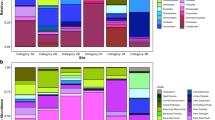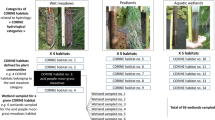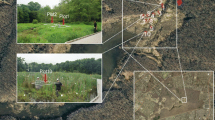Abstract
Current methods of wetland assessment rely on the use of ecological indicators such as vegetation and amphibians, but often lack an in-depth analysis of soil parameters. The objective of this study was to determine whether the Ohio Rapid Assessment Method (ORAM) can be used to predict soil quality in forested wetlands. Soil cores were taken from six wetlands ranging in ORAM scores. The soil samples were analyzed for key soil parameters (aggregate stability, bulk density, organic matter, C, N, S, P, microbial biomass, and enzyme activity). Some of these soil parameters (i.e., microbial biomass, soil C, N and S, bulk density, soil moisture) were correlated with the ORAM scores, while others (i.e., P, pH, aggregate stability) showed no correlation. Enzyme activity was correlated with the ORAM score for one of the four sampling events. When analyzed together by a principal component analysis, the soil parameters did not separate the wetland sites along a gradient of ORAM scores. Our results indicate that the ORAM reflects some of the key soil quality conditions, but not all. We further discuss whether some of the soil parameters we selected are appropriate indicators of the quality of wetland soils.
Similar content being viewed by others
Literature Cited
Balota, E. L., A. Colozzi-Filho, D. S. Andrade, and R. P. Dick. 2003. Microbial biomass in soils under different tillage and crop rotation systems. Biology and Fertility of Soils 38: 15–20.
Barbhuiya, A. R., A. Arunachalan, H. N. Pandey, K. Arunachalan, M. L. Khan, and P. C. Nath. 2004. Dynamics of soil microbial biomass C, N, and P in disturbed and undisturbed stands of a tropical wet-evergreen forest. European Journal of Soil Science 40: 113–21.
Bending, G. D., M. K. Turner, F. Ryans, M. Marie-Claude, and M. Woods. 2004. Microbial and biochemical quality indicators and their potential for differentiating areas under contrasting agriculture management regimes. Soil Biology and Biogeochemistry 36: 1785–92.
Blake, G. R. 1965. Bulk density. p. 374–90. In C. A. Black (ed.) Methods of Soil Analysis, Part II. American Society of Agronomy, Madison, WI, USA.
Breckenridge, R. D., W. G. Kepner, and D. A. Mouat. 1995. A process for selecting indicators for monitoring conditions of rangeland health. Environmental Monitoring and Assessment 36: 45–60.
Brinson, M. M. 1993. A hydrogeomorphoc classification for wetlands. Wetlands Research Program Technical Report WRP-DE-4. United States Army Corps of Engineers, Washington, DC, USA.
Brooks, R. P., D. H. Wardrop, and J. A. Bishop. 2002. Watershed-based protection for wetlands in Pennsylvania: Levels 1&2: Synoptic maps and rapid field assessments. Final Report to Pennsylvania Department of Environmental Protection Penn State Cooperative Wetlands Center, Pennsylvania State University, University Park, PA, USA.
Brown, M. T. and M. B. Vivas. 2004. A landscape development intensity index. Ecological Monitoring and Assessment 101: 289–309.
Dick, R. P. 1994. Soil enzyme activities as indicators of soil quality. p. 107–24. In J. W. Doran, D. C. Coleman, D. F. Bezdicek, and B. A. Stewart (eds.) Defining Soil Quality for a Sustainable Environment. Soil Science Society of America Special Publication 33, Minneapolis, MN, USA.
Dinesh, R., S. G. Chaudhuri, A. N. Ganeshamurthy, and S. C. Pramanik. 2004. Biochemical properties of soils of undisturbed and disturbed mangrove forests of South Andaman (India). Wetlands Ecology and Management 12: 309–20.
Doran, J. W. and M. Safley. 1997. Defining and assessing soil health and sustainable productivity. p. 1–28. In C. Pankhurst, B. M. Doube, and V. V. S. R. Gupta (eds.) Biological Indicators of Soil Health. CAB International, WallingfordOxford, UK.
Fennessy, M. S., M. Gernes, J. J. Mack, and D. H. Wardrop. 2001. Methods for evaluating wetland condition: using vegetation to assess environmental conditions in wetlands. EPA-822-R-02-020. U.S. Environmental Protection Agency, Office of Water, Washington, DC, USA.
Fennessy, S., A. Jacobs, and M. Kentula. 2007. An evaluation of rapid methods for assessing the ecological condition of wetlands. Wetlands 27: 504–21.
Filip, Z. 2002. International approach to assessing soil quality by ecologically-related biological parameters. Agriculture, Ecosystems and Environment 88: 169–174.
Freeland, J. A., J. L. Richardson, and L. A. Foss. 1999. Soil indicators of agricultural impacts on Northern prairie pothole wetlands: Cottonwood Lake Research Area, North Dakota, USA. Wetlands 19: 56–64.
Freeman, C., G. Liska, M. A. Lock, B. Reynolds, and J. Hudson. 1996. Microbial activity and enzymatic decomposition followingpeatland water table drawdown. Plant and Soil 180: 121–27.
Gernes, M. C. and J. C. Helgen. 1999. Index of biological integrity (IBI) for large depressional wetlands in Minnesota. Final Report to the United States Environmental Protection Agency Assistance Number CD995525-01, April 1999. Minnesota Pollution Control Agency, St. Paul, Minnesota, USA.
Gil-Sotres, F., C. Trasar-Cepeda, M. C. Leiros, and S. Seoane. 2005. Different approaches to evaluating soil quality using biochemical properties. Soil Biology and Biogeochemistry 37: 877–87.
Hicks, A. L. and B. K. Carlisle. 1998. Rapid habitat assessment of wetlands, macro-invertebrate survey version: brief description and methodology. Massachusetts Coastal Zone Management Assessment Program, Amherst, MA, USA.
Hossler, K. 2005. Accumulation of carbon in created wetland soils and the potential to mitigate loss of natural wetland carbon-mediated functions. MS Thesis, Ohio State University, USA.
Innis, S. A., R. J. Naiman, and S. R. Elliott. 2000. Indicators and assessment for measuring the ecological integrity of semi-aquatic terrestrial environments. Hydrobiologia 422/433: 111–31.
Izquierdo, I. F., M. Caravaca, M. Alguacil, G. Hernandez, and A. Roldan. 2005. Use of microbiological indicators for evaluating success in soil restoration after revegetation of a mining area under subtropical conditions. Applied Soil Ecology 30: 3–10.
Jordan, T. E., M. P. Andrews, R. P. Szuch, D. F. Whigham, D. E. Weiler, and A. D. Jacobs. 2007. Comparing functional assessment of wetlands to measurements of soil characteristics and nitrogen processing. Wetlands 27: 479–97.
Kang, H., C. Freeman, D. Lee, and W. J. Mitsch. 1998. Enzyme activities in constructed wetlands: implications for water quality amelioration. Hydrobiologia 386: 231–35.
Kang, H. and C. Freeman. 1999. Phosphatase and arylsulphatase activities in wetland soils: annual variation and controlling factors. Soil Biology and Biochemistry 31: 449–454.
Karr, J. R. 1981. Assessment of biotic integrity using fish communities. Fisheries 6: 21–27.
Kemper, W. D. and W. S. Chepil. 1965. Size distribution of aggregates. p. 499–510. In C. A. Black, C.A. (ed.) Methods of Soil Analysis, Part 1, No. 9. American Society of Agronomy, Madison, WI, USA.
Knight, T. R. and R. P. Dick. 2004. Differentiating microbial and stabilized Betaglucosidase activity relative to soil quality. Soil Biology and Biogeochemistry 36: 2089–96.
Kuperman, R. G. and M. M. Carreiro. 1997. Soil heavy metal concentrations, microbial biomass and enzyme activities in a contaminated grassland ecosystem. Soil Biology and Biogeochemistry 29: 179–90.
Mack, J. J. 2001a. Ohio rapid assessment method for wetlands v.5.0, users manual and scoring score. Ohio Environmental Protection Agency, Wetlands Ecology Group, Division of Surface Water, Columbus, OH, USA.
Mack, J. J. 2001b. Vegetation index of biological integrity (VIBI) for wetlands. Ohio Environmental Protection Agency, Wetlands Ecology Group, Division of Surface Water, Columbus, OH, USA.
Mack, J. J. 2004. Integrated wetland assessment program. Part 4: a vegetation index of biotic integrity (VIBI) and tiered aquatic life uses (TALUs) for Ohio Wetlands. Ohio EPA Technical Report WET/2004-4. Ohio Environmental Protection Agency, Wetlands Ecology Group, Division of Surface Water, Columbus, OH, USA.
Mack, J. J. 2006. Landscape as a predictor of wetland condition: an evaluation of the landscape development index (LDI) with a large reference wetland dataset from Ohio. Environmental Monitoring and Assessment 120: 221–41.
Micacchion, M. 2004. Integrated wetland assessment program. Part 7: amphibian index of biotic integrity for Ohio Wetlands. Ohio EPA Technical Report WET/2004-7. Ohio Environmental Protection Agency, Wetlands Ecology Group, Division of Surface Water, Columbus, OH, USA.
Nimmo, J. and K. Perkins. 2002. Aggregate stability and size distribution. p. 317–28. In J. H. Dane and G. C. Topp (eds.) Methods of Soil Analysis, Part 4, Physical Methods. Soil Science Society of America Book Series No. 5: Madison, WI, USA.
Pennings, S. C., V. Dan Wall, D. J. Moore, M. Pattanayek, T. L. Buck, and J. J. Alberts. 2002. Assessing salt marsh health: a test of the utility of five potential indicators. Wetlands 22: 405–414.
Reiss, K. C. 2006. Florida wetland condition index for forested wetlands. Ecological Indicators 6: 337–52.
Roldan, A., J. R. Salinas-Garcia, M. M. Alguacil, and F. Caravaca. 2005a. Changes in soil enzyme activity, fertility, aggregation and C sequestration mediated by conservation tillage practices and water regime management in a maize field. Applied Soil Ecology 30: 11–20.
Roldan, A., J. R. Salinas-Garcia, M. M. Alguacil, E. Diaz, and F. Caravaca. 2005b. Soil enzyme activities suggest advantages of conservation tillage practices in sorghum cultivation under subtropical conditions. Geoderma 129: 178–85.
Schloter, M., J. C. O’Dilly, and J. C. Munch. 2003. Indicators for evaluating soil quality. Agriculture, Ecosystems and Environment 98: 255–62.
Sicardi, M., F. Garcia-Prechac, and L. Frioni. 2004. Soil microbial indicators sensitive to land use conversion from pastures to commercial Eucalyptus grandis (Hill ex Maiden) plantations in Uruguay. Applied Soil Ecology 27: 125–33.
Sparling, G. P. 1997. Soil microbial biomass, activity, and nutrient cycling as indicators of soil health. p. 97–119. In C. Pankhurst, B. M. Doube, and V. V. S. R. Gupta (eds.) Biological Indicators of Soil Health. CAB International, New York, NY, USA.
Spencer, C., A. I. Robertson, and A. Curtis. 1998. Development and testing of a rapid appraisal wetland condition index in south-eastern Australia. Journal of Environmental Management 54: 143–59.
Tabatabai, M. A. 1994. Soil enzymes. p. 775–833. In R. W. Weaver, J. S. Angle, and P. S. Bottomley (eds.) Methods of Soil Analysis, Part 2, Microbiological and Biochemical Properties. Soil Science Society of America Book Series No. 5: Madison, WI, USA.
van Dam, R. A., C. Camilleri, and C. M. Finlayson. 1998. The potential of rapid assessment techniques as early warning indicators of wetland degradation: a review. Environmental Toxicology and Water Quality 13: 297–312.
Vance, E. D., P. C. Brookes, and D. S. Jenkinson. 1987. An extraction method for measuring soil microbial biomass C. Soil Biology and Biogeochemistry 19: 703–07.
Villar, M. C., V. Petrikova, M. Diaz-Ravina, and T. Carballas. 2004. Changes in soil microbial biomass and aggregate stability following burning and soil rehabilitation. Geoderma 122: 73–82.
Author information
Authors and Affiliations
Rights and permissions
About this article
Cite this article
Rokosch, A.E., Bouchard, V., Fennessy, S. et al. The use of soil parameters as indicators of quality in forested depressional wetlands. Wetlands 29, 666–677 (2009). https://doi.org/10.1672/08-150.1
Received:
Accepted:
Issue Date:
DOI: https://doi.org/10.1672/08-150.1




